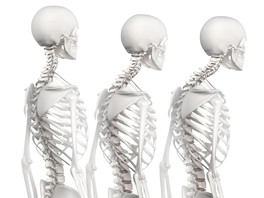

Kyphosis describes a spinal curve that exists primarily in the thoracic spine (12 vertebrae in the upper back). Kyphosis causes rounding of the upper back or hunchback. Some degree of rounding is normal and is found in every individual. Kyphosis is more common in women than men. Symptoms may include back pain and stiffness, fatigue, or in severe cases difficulty breathing.

Common Causes
More severe forms of kyphotic deformities (excessive kyphosis) may be caused by:
Postural kyphosis is a result of slouching or poor posture
Adolescent kyphosis, or Scheuermann’s disease (a skeletal disorder of childhood), is caused by the wedging together of several vertebrae.
Diagnosis/Examination
To receive a diagnosis, a qualified musculoskeletal expert will first take a medical history and conduct a physical exam. They will do a full exam and look for any neurological symptoms such as weakness, paralysis and changes in sensation below the curve.
Diagnostic tests may be ordered such as: X-rays, MRI, CT scans, or pulmonary function tests.
Treatment
Conservative treatments include physical therapy and in some cases a brace may be recommended. Your doctor might suggest pain relievers to help alleviate discomfort. In more severe cases, surgical treatment can be performed to reduce the curve of the spine.
Prevention
Treating and preventing osteoporosis can prevent many cases of kyphosis in the elderly. Early diagnosis and bracing with Scheuermann’s disease can reduce the need for surgery, but there is no way to prevent the disease.
Copyright © www.orthopaedics.win Bone Health All Rights Reserved